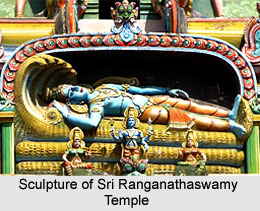 Sri Ranganathaswamy Temple is dedicated to Lord Ranganatha, another form of Lord Vishnu. The temple has 21 gopurams. Another important feature of the temple is its 1000 pillared hall. The main feature of Vijayanagar sculptures is a well built enclosure and this is very much present in this temple. Another important feature of the sculpture of Sri Ranganathaswamy Temple is the rajagpopuram. These barrel structures are decorated with several well four etched out figures of Hindu deities.
Sri Ranganathaswamy Temple is dedicated to Lord Ranganatha, another form of Lord Vishnu. The temple has 21 gopurams. Another important feature of the temple is its 1000 pillared hall. The main feature of Vijayanagar sculptures is a well built enclosure and this is very much present in this temple. Another important feature of the sculpture of Sri Ranganathaswamy Temple is the rajagpopuram. These barrel structures are decorated with several well four etched out figures of Hindu deities.
Another outstanding sculpture of Sri Ranganathaswamy Temple is to be found on the "Sesha Mandap." The 1000 pillared hall actually has 953 pillars. This is a well planned unit that is reminiscent of a theatre. The Shesha mandapa lies in its opposite direction. Sculptures are placed in the niches of three sides of the sanctuary walls. The pillars consist of sculptures of wild rearing horses bearing riders on their backs and trampling with their hoofs upon the heads of rampant tigers. The piers lining the central aisle have courtly portrait sculptures. A free standing shrine inside the hall contains a large seated figure of garuda and the eagle headed god faces north towards the principal sanctum. Elephant barriers go round the entrance steps that rise to a spacious open area. This is bounded by decorated piers with rearing animals. The hall has leaping animals carved on to the piers at its northern end.
This article is a stub. You can enrich by adding more information to it. Send your Write Up to content@indianetzone.com



















